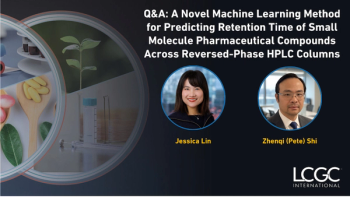
Measuring the Effects of Solutes on pH Retention Using Liquid Chromatography
Karlstad University scientists modeled pH-dependent retention and competitive adsorption of solutes using mixed-mode and reversed-phase liquid chromatography.
Scientists from Karlstad University in Karlstad, Sweden recently modeled pH-dependent retention and competitive adsorption of solutes using mixed-mode and reversed-phase liquid chromatography (RPLC). Their findings were published in the Journal of Chromatography A (1).
Base analysis, which makes up the largest group of small-molecule drugs, has been a major concern in reversed-phase liquid chromatography (RPLC). This stems from issues like peak tailing, low efficiency, and low loading capacities, which could be primarily ascribed to secondary ionic interactions between charged bases and residual silanolates of stationary phases. Various strategies, such as reducing the residual silanol by extensive end-capping, operating the column at low pH where any silanols, if present, would be uncharged, using polymeric columns that lack surface silanols, and the inclusion of additives such as tertiary amines in the mobile phase, can help improve basic solute separation under consideration, though they did not fully solve these issues. This has led to alternative high-performance liquid chromatography (HPLC) separation modes, such as ion-pair liquid chromatography, ion-exchange liquid chromatography, hydrophilic interaction liquid chromatography (HILIC), and mixed-mode liquid chromatography (MMLC), being employed to separate basic solutes under different conditions.
For this study, the scientists looked into pH’s influence on solute retention using a mixed-mode column with carboxyl (-COOH) groups acting as weak cation exchanger bonded to the terminal of C18 ligands (C18-WCX column) and a traditional reversed-phase C18 column. First, a model based on electrostatic theory was created and used to predict the retention of charged (and ionizable) solutes as a function of mobile phase pH on a V18-WCX column. The developed model is partly based on the Horváth model, where the retention factor of a solute is controlled through the degree of ionization (which depends on the mobile phase’s pH) with two limiting factors: the retention factor is minimum when the solute is completely uncharged, and the retention factor is maximum when the solute is completely charged. The Horváth Model, which is often used as a first estimate to predict the retention factor of ionizable solutes as a function of the mobile phase pH, does have limitations; namely changes in surface potential with pH, which can occur due to factors such as the ionization of residual silanols on silica-based columns and ion exchange ligands in some columns, are not accounted for by the model. While the model does predict pH-dependent retention of ionizable solutes in RPLC, the developed model incorporates the concept of surface potential generated on the surface of the stationary phase and its variation with pH.
To better understand the adsorption process, adsorption isotherms for these solutes were individually acquired on the C18-WCX and reversed-phase C18 columns. The elution profiles for single components were calculated from the adsorption isotherms using the equilibrium dispersion column model and were found to be in close agreement with the experimental elution profiles. To enable modelling of two-component cases involving charged solute(s), a competitive adsorption isotherm model based on electrostatic theory was derived.
This model was used to calculate the elution profiles of two components for scenarios involving a C18 Column with two charged solutes, a C18 Column with one charged and one uncharged solute, and a C18-WCX Column with two charged solutes. All three scenarios showed strong alignment between the experimental and calculated elution profiles, validating the developed competitive adsorption model. As such, the competitive adsorption isotherms developed in this study were implicit, meaning that the amount of solute adsorbed on the stationary phase is a function of the solute already adsorbed on the stationary phase. While these models could pose several challenges, said issues were addressed in this study.
Reference
(1) Haseeb, A.; Fernandes, M. X.; Samuelsson, J. Modelling the pH Dependent Retention and Competitive Adsorption of Charged and Ionizable Solutes in Mixed-Mode and Reversed-Phase Liquid Chromatography. J. Chromatogr. A 2024, 1730, 465058. DOI:
Newsletter
Join the global community of analytical scientists who trust LCGC for insights on the latest techniques, trends, and expert solutions in chromatography.




